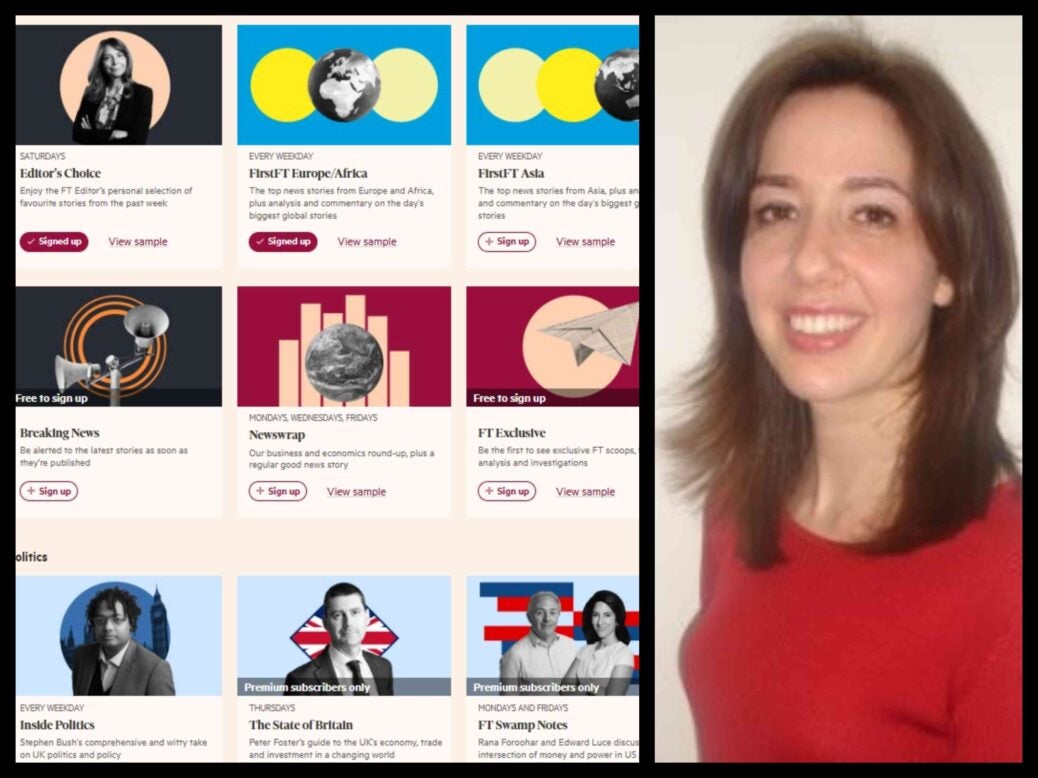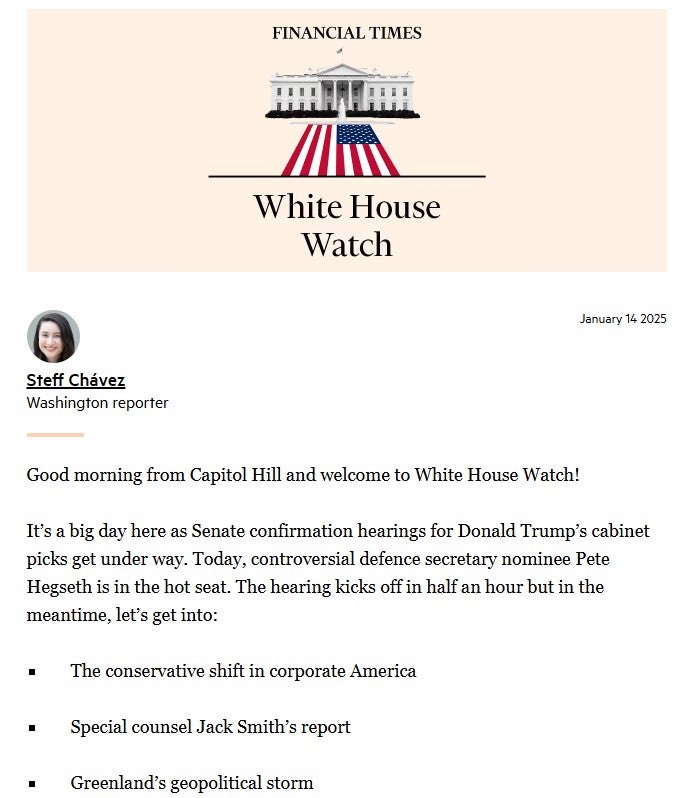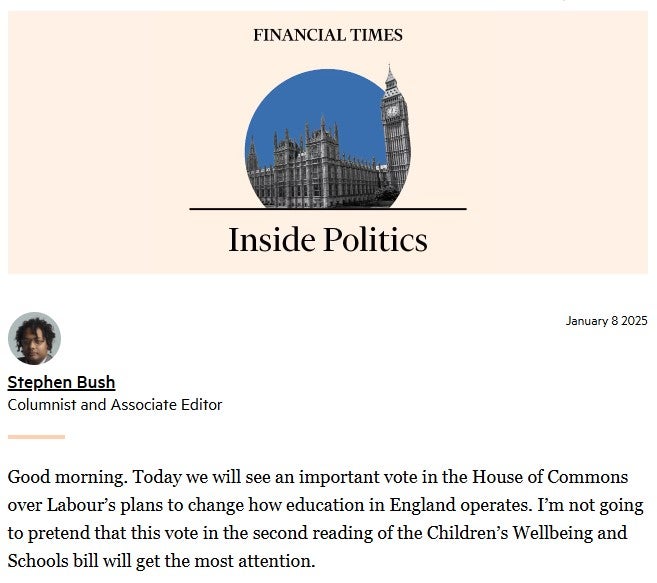
Over four years at the Financial Times, head of newsletters Sarah Ebner has helped grow its email subscribers from over 400,000 to 1.6 million.
She told Press Gazette that email newsletters are now the biggest driver of reader engagement at the FT. They are also hugely important for driving subscriber loyalty and finding new paying readers as well as providing advertising and subscription revenue in their own right.
The FT runs 16 premium newsletters (made available as a perk to those on more expensive subscriptions), 17 standard newsletters which are available to all paying FT subscribers, five free newsletters, two evergreen course-based newsletters and 11 automated emails (made of aggregated headlines). Three of the paid newsletters can also be paid for on a standalone basis by non-FT subscribers.
As an executive editor Ebner is also on the FT’s senior editorial leadership team. She answered Press Gazette’s questions about publisher newsletter strategies and how newsbrands can best use email to support their journalism.
Publisher newsletter strategies with FT head of newsletters Sarah Ebner
How are important are email newsletters as a platform for the Financial Times?
“I’ve been here nearly four years and they were really being used solely as an engagement tool and as part of our loyalty strategy. But we’ve started using them more for acquisition as well and had a lot of success with that.
“Last year we had some registration targets because someone’s more likely to become a subscriber if they’ve first been a registrant. So we were trying to increase our pool of registrants and we did this, particularly with our US Election Countdown newsletter, which is now called White House Watch. We’ve had massive success with that newsletter. It’s had over 100,000 signups and it’s free.
“Newsletters are obviously really important when it comes to getting the FT to people and expanding our reach. The premium and standard subscription thing means they also protect against readers downgrading their subscription.”

How have newsletters changed over the years that you’ve been involved in them?
“I started doing newsletters when I was at The Times, so I’ve been doing them for a decade or more. I think at the beginning, people didn’t really understand what they were or what they could do and I think they were very often just seen as traffic drivers.
“Then they were seen as something valuable for subscribers, which I think is a pretty accurate description. But they were still not really very personality-driven and often given to someone junior, like as an extra thing, ‘could you write this newsletter’?
“What has really changed is the rise of the personality-driven newsletter, showcasing someone who’s really good and making it an extra vehicle for them. They offer massive added value.
“I do think there’s still a place for those traffic-driving ones, but for us, I would say our most successful newsletters are the big personality newsletters that our readers really value. The metrics for those are not traffic to the site or traffic at all. They are read in your inbox, with amazing bespoke exclusive content. And I think that’s what’s really changed.”
You’ve launched some newsletters that readers can subscribe to as standalone products. How are they going?
“We have three: Inside Politics, by Stephen Bush, we have Unhedged, which is Rob Armstrong’s US markets newsletter. And we also have a course called Sort Your Financial Life Out with Claer Barrett, which you can sign up for as an evergreen course.
“We did this because partly we thought we should get these out to more people and partly because obviously they might lead people to take out a subscription to the FT. We wanted to put some of our best newsletters out there to try that out.
“We have hardly any cancellations for those so they certainly work well, and the numbers are small, but growing. I think the problem is how you push this out, how you get people to know about them, because obviously the commercial side of the business want you to take out an FT subscription more than they want you to sign up for Stephen’s newsletter for £4.99 a month.
“But I think there’s people who might never take out a subscription who would sign up for Stephen’s newsletter and that’s what we’ve seen. It’s also a good way to get people from the podcast, which is free to listen to, to engage by paying something for the FT.

“We’re always looking at trying to introduce lower price products. Claer’s course was really interesting for that. It’s a brilliant course, by the way, and we’ve had lots of subscribers sign up for it because they get it for free, but also many, many hundreds of people who have signed up for it as an individual product.
“A large portion of those were younger than our normal usual FT audience and also it skewed more female. So we were trying to get new audiences, and succeeded.”
We need to talk about open rates. What metrics do you look at?
“With the free ones, we’re looking at traffic and we’re also looking at conversions, because obviously we want people to become FT subscribers.
“I launched a newsletter soon after I came called Editor’s Digest, which only goes to registrants and the entire aim of that newsletter is to get people to convert to being a subscriber. And it is our most successful one for conversions.
“When it comes to newsletter metrics overall, it’s really vital to know what your aims are. Establish your goals first. I have no issue at all with different metrics for different newsletters.
“So it might be traffic to the site, it might be the size of the list, it might be conversions to paying subscribers, it might be experimentation, like getting more registrants… time on site from newsletters, unsubscribes, sponsorship.
“So what do you want your newsletter to accomplish and how can you measure it?
“I do look at open rate, although we all know that Apple’s made that very unhelpful because it opens emails on a person’s behalf. But we don’t count Apple opens in ours so we have a verifiable open rate.
“But even if you don’t have that, you should be able to compare your own newsletters with your other own newsletters. I’m very wary about comparing mine to outside newsletters, because they’ll all be over-inflating.
“I do look at click-through rates but I look more at what we call action rates, which is people who’ve opened the newsletter, how they click.
“Obviously I look at the size of the list because I want to see they’re growing. And I look at unsubscribes because I want to see that people aren’t choosing to unsubscribe.
“But I’m also very interested in soft metrics now, which is things like feedback.
“Do people respond to your newsletter? Do they send in emails? Do they fill in the polls that you have in there?
“With our reader survey, we ask why people signed up for the newsletter. And the top answer is always something like, to discover things I would have missed, to stay up to date and to get an insightful perspective. And I think that’s just a brilliant summary of newsletters in general.”
What is a good open rate?
“Open rates have gone up a lot in the last few years because they’re not real and most people use Apple. So they’re really overinflated.
“In the past, people used to say, oh, 35 % is a good open rate. And now they say much higher than that.
“But I would say, if you ignore the Apple thing, 35% is still a good open rate. And then anything over 40 is particularly good if you’re doing it properly, verifiably.
“Don’t look at data the next day, because it will go up and up because people won’t necessarily read it that day. Give it a little bit of time before you check your metrics.”
What makes a good subject line?
“It has to be something that makes people want to open your email. So it has to stand out. I always say the inbox is crowded, how do you make your newsletter stand out? So I think they should be short and grabby.
“Sometimes you can just use one word which we do with some of our newsletters.
“You have to think ‘what’s going to make someone open this?’ There’s some psychology in that so test if you can, and look back at your data and see what worked.
“We were having a funny conversation literally today about how Trump was leading to higher opens, EU led to lower opens. How do we get around that?
And we thought, perhaps we should use the names of specific countries rather than EU overall, which I think is probably correct. We’ll try that and see how it works.”
So many journalism platforms appear to be in decline. How are newsletters standing up?
“In the ten years that I’ve been doing newsletters people have gone, oh, it’s the death of the newsletter. You read that and then you read it’s the Renaissance of the newsletter.
“I just think, well, everyone’s still using email. I mean, they might be using Slack as well or other things as well, but they’re using email too, so that’s great.
“We bypass social media algorithms, which are really flaky. People really want that first-party contact with their reader.
“I think that it will stay. No one’s managed to come up with a replacement for email yet.
“I know there’s Whatsapp and other things, but I still think people come back to it. And it’s still a really nice way to read something long.
“Also you can keep a record of it because it’s in your inbox, as opposed to certain things where things disappear, like Snap. So I think it is here to stay.”
Any final tips for publishers looking to super-charge their newsletters strategy?
“Put really good people on them and take them seriously. Have a look at your data and see what a person is doing very well for – I don’t know, conversion or visits – and think about giving them a newsletter.”
Email pged@pressgazette.co.uk to point out mistakes, provide story tips or send in a letter for publication on our "Letters Page" blog
